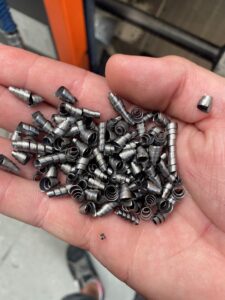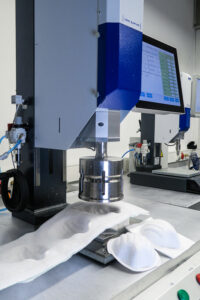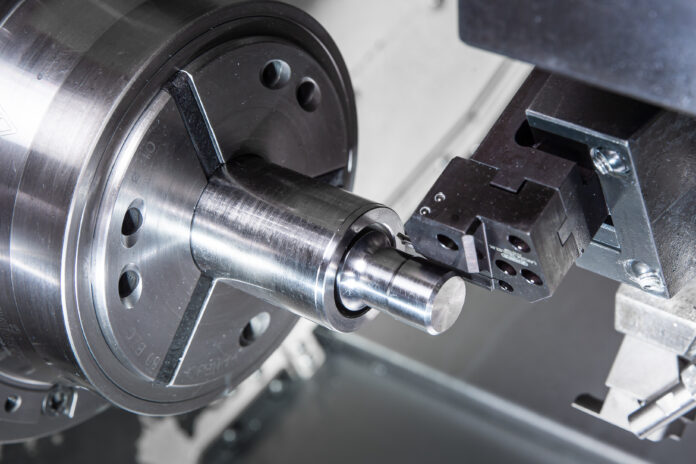The manufacturer of ultrasonic welding equipment for mask production, among other things, wanted more process reliability in the machining of materials that are difficult to machine: With tools from Paul Horn GmbH and cooling lubricants from Zeller+Gmelin, the Karlsbad-based specialist for ultrasonic components and systems was able to find two suitable partners at once.
The ultrasonic systems are used, for example, in the production of a wide variety of medical technology applications, for example medical masks or medical components such as membranes, adapters and connectors and even surgical instruments. In particular, the demand for ultrasonic welding technology for the series production of medical masks made of non-woven fabric has increased dramatically due to the pandemic. The vertical range of manufacture at Weber Ultrasonics is enormous: almost all components and assemblies of the ultrasonic systems are manufactured in-house. For a special titanium component, the so-called converter, the machining process used is grooving, or more precisely axial grooving. In order to be able to guarantee process reliability and long tool life even with increasing quantities, new tool solutions were sought. Previously, chatter marks on the surface of the deep grooves were a recurring problem.
Zubora ensures more process reliability
 With a new axial grooving system from the Tübingen tool specialist Horn, a process-safe solution was found: the new S15A grooving insert had produced a stable machining process right away. At the same time, a new cooling lubricant is used in the form of Zubora TTS, which was developed in a joint project between Horn, Zeller+Gmelin and a major machine manufacturer. “All the experience of the lubricant manufacturer, machine builder and tool specialist has gone into the development of the new lubricant,” says Jürgen Schmid, Product and Project Manager Sales at Horn, seeing an enormous advantage. “The idea of the project was to develop a new and more efficient coolant for the machining of superalloys. Zeller+Gmelin has achieved this with the development of the new coolant.” And Business Unit Manager Thorsten Wechmann from Zeller+Gmelin adds: “After successful tests on various superalloys, the first field test at Weber Ultrasonics was now on the agenda. By using Zubora TTS in combinat
With a new axial grooving system from the Tübingen tool specialist Horn, a process-safe solution was found: the new S15A grooving insert had produced a stable machining process right away. At the same time, a new cooling lubricant is used in the form of Zubora TTS, which was developed in a joint project between Horn, Zeller+Gmelin and a major machine manufacturer. “All the experience of the lubricant manufacturer, machine builder and tool specialist has gone into the development of the new lubricant,” says Jürgen Schmid, Product and Project Manager Sales at Horn, seeing an enormous advantage. “The idea of the project was to develop a new and more efficient coolant for the machining of superalloys. Zeller+Gmelin has achieved this with the development of the new coolant.” And Business Unit Manager Thorsten Wechmann from Zeller+Gmelin adds: “After successful tests on various superalloys, the first field test at Weber Ultrasonics was now on the agenda. By using Zubora TTS in combinat
ion with a new tool coating, the tool life could be significantly increased. The completely new formulation leads not only to an increase in tool life but also to an improvement in the surface quality of the component. Furthermore, it was possible to increase the cutting parameters and thus sustainably increase profitability.”
Chip breaking under control
 Weber Ultrasonics says that by optimally matching the tool and the cooling lubricant, it has been possible to significantly improve chip control. As a result, 50 of the titanium components can now be produced off the shelf in an unmanned shift, so to speak, and the problem of uncontrolled long chips is now a thing of the past. Tool wear has also improved measurably and visibly thanks to the new Zubora coolant.
Weber Ultrasonics says that by optimally matching the tool and the cooling lubricant, it has been possible to significantly improve chip control. As a result, 50 of the titanium components can now be produced off the shelf in an unmanned shift, so to speak, and the problem of uncontrolled long chips is now a thing of the past. Tool wear has also improved measurably and visibly thanks to the new Zubora coolant.
The new cooling lubricant Zubora TTS is a fully synthetic solution. According to manufacturer Zeller+Gmelin, the focus of the novel concept was on lubrication, chip breakage support and surface quality improvement. “We have developed the new coolant for the productive machining of titanium and other superalloys. However, the product can be used multi functionally and also brings advantages when machining a variety of other materials,” explains Thorsten Wechmann.
About Zeller+Gmelin
Zeller + Gmelin GmbH & Co. KG, founded in 1866, employs over 900 people worldwide, almost half of whom work at its headquarters in Eislingen. With its 16 subsidiaries, the medium-sized company operates worldwide. The product portfolio is divided into the divisions lubricants, industrial chemicals, and printing inks. The high-quality products occupy a leading position on the international market. Zeller+Gmelin offers individual and integrated solutions from a single source, from research and development to production. The high proportion of R&D is shown not least by the fact that around 20 percent of the employees in Eislingen work in this area in order to permanently develop and optimize the innovative products in line with market and customer requirements.



















